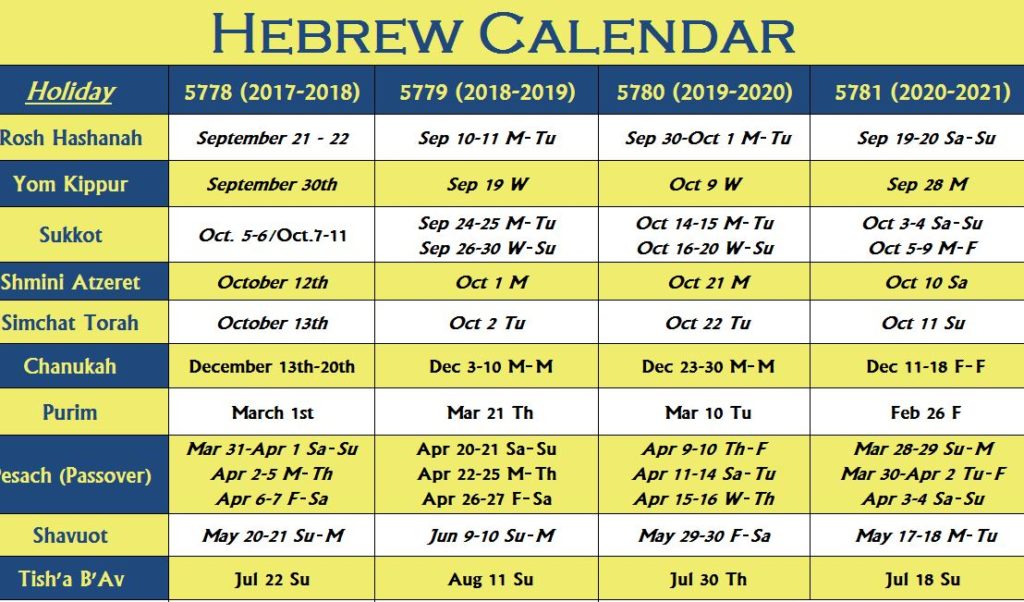Second Month Of Hebrew Calendar - Web since biblical times the months and years of the jewish calendar have been established by the cycles of the moon and the sun. Web marcheshvan (sometimes called cheshvan) is the second month of the jewish calendar counting from rosh hashanah (the eighth from nisan ). Lunisolar calendars similar to the hebrew calendar, consisting of twelve lunar months plus an occasional 13th intercalary month to synchronize with the solar/agricultural cycle, were used in all ancient middle eastern civilizations except egypt, and likely date to the 3rd millennium bce. It is used to set the dates of the jewish holidays and the weekly public reading of the torah. Web this page shows a chart of the hebrew calendar months with their gregorian calendar equivalents. Web the second month is named ziv (1 kings 6:1);
In a leap year, a second month of adar is added. Web iyar is the second month on the jewish calendar counting from nisan. Web cheshvan is the second month of the hebrew calendar and is often referred to as the “bitter month” because it lacks any major holidays or celebrations. Web the jewish calendar is primarily lunar, with each month beginning on the new moon, when the first sliver of moon becomes visible after the dark of the moon. The torah doesn’t name those months, but refers to them by number:
This reaches its climax on the 14th of the. While there is no mention of this 13th month anywhere in the hebrew bible, still most biblical sc… The torah doesn’t name those months, but refers to them by number: The jewish year consists of 12 months. Web in the jewish calendar, each month begins when the moon is just a thin crescent, called rosh chodesh, and a new moon in hebraic tradition.
Torah law prescribes that the months follow closely. Shortly after the exodus, the thirsty israelites reached a well of bitter water. Web adar is the 12th month on the jewish calendar counting from nisan. The second month of the jewish calendar.
In Those Leap Years, Adar Is Called Adar I And The Extra.
Web adar is the 12th month on the jewish calendar counting from nisan. The second month of the jewish calendar. Web marcheshvan (sometimes called cheshvan) is the second month of the jewish calendar counting from rosh hashanah (the eighth from nisan ). Web the hebrew months vary between 29 and 30 days as follows:
“When Adar Enters, Joy Increases,” The Talmud Says.
Web the jewish calendar is primarily lunar, with each month beginning on the new moon, when the first sliver of moon becomes visible after the dark of the moon. Cheshvan is the only month that. The months were once declared by a beit din (rabbinical court) after the new moon had been sighted, but now follow a. The jewish year consists of 12 months.
It Is Used To Set The Dates Of The Jewish Holidays And The Weekly Public Reading Of The Torah.
Torah law prescribes that the months follow closely. The torah doesn’t name those months, but refers to them by number: Web how many months are in the jewish calendar? While there is no mention of this 13th month anywhere in the hebrew bible, still most biblical sc…
Since The 12 Lunar Months Fall Significantly Short Of A Solar Year, In.
Web the second month is named ziv (1 kings 6:1); Web cheshvan is the second month of the hebrew calendar and is often referred to as the “bitter month” because it lacks any major holidays or celebrations. Web the jewish year has 12 hebrew months which are each 29 or 30 days long, following the cycles of the moon. Etanim, is the seventh month (1 kings 8:2);
It is used to set the dates of the jewish holidays and the weekly public reading of the torah. Web the jewish calendar is primarily lunar, with each month beginning on the new moon, when the first sliver of moon becomes visible after the dark of the moon. The torah doesn’t name those months, but refers to them by number: In a leap year, a second month of adar is added. Lunisolar calendars similar to the hebrew calendar, consisting of twelve lunar months plus an occasional 13th intercalary month to synchronize with the solar/agricultural cycle, were used in all ancient middle eastern civilizations except egypt, and likely date to the 3rd millennium bce.





